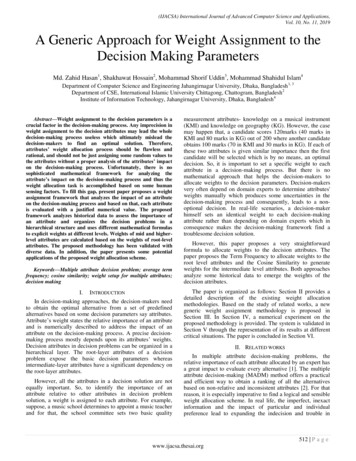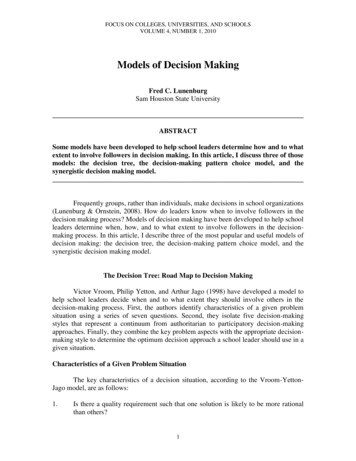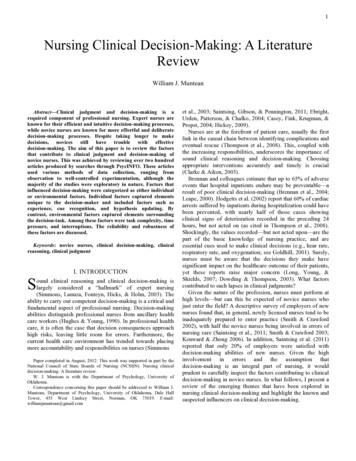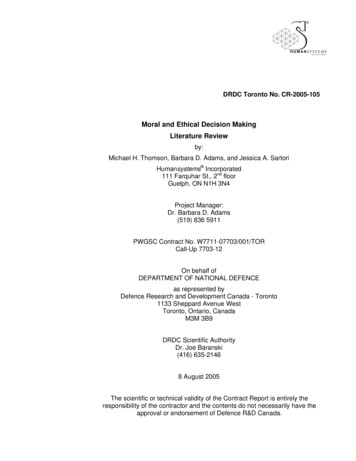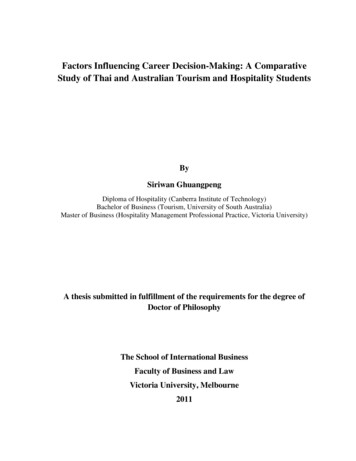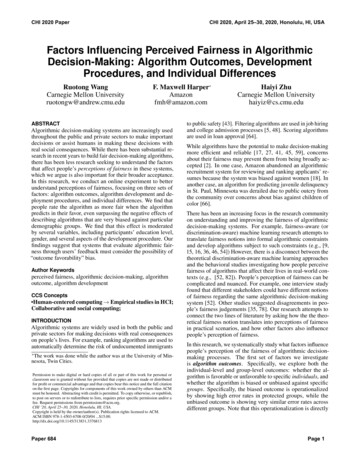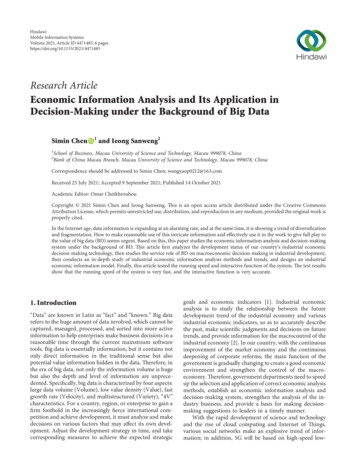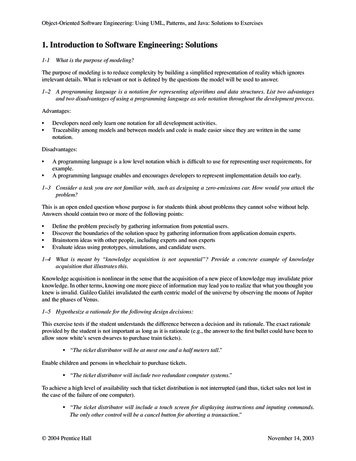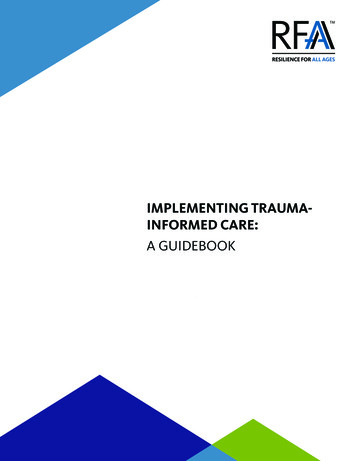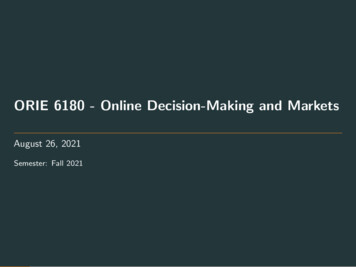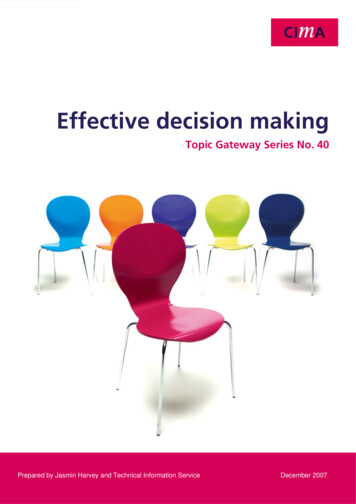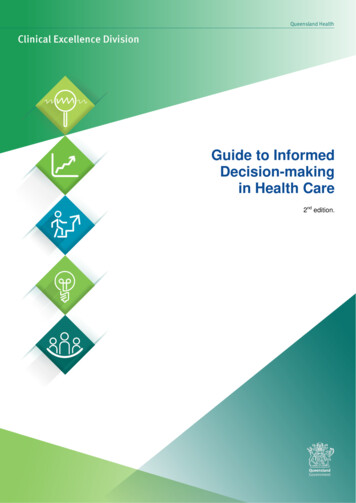
Transcription
Guide to InformedDecision-makingin Health Care2nd edition.
DisclaimerThe information within the Guide to Informed Decision-making in Health Care is intended as a guide to goodclinical practice. The law and service delivery environment is constantly evolving, so while every attempt hasbeen made to ensure the content is accurate, it cannot be guaranteed. The information within this documentshould not be relied upon as a substitute for other professional or legal advice.ISBN 9781921707391 State of Queensland (Queensland Health) 2017This work is licensed under a Creative Commons Attribution Non-Commercial 2.5 Australian license. To viewa copy of this license, visit n essence, you are free to copy, communicate and adapt the work for non-commercial purposes, as long asyou attribute the Patient Safety and Quality Improvement Service, Queensland Health and abide by thelicense terms.For further information, contact:Patient Safety and Quality Improvement ServiceClinical Excellence DivisionPO Box 2368Fortitude Valley BC 4006Phone:Email:Website:( 61) (07) 3328 d.govFor permission beyond the scope of this license contact:Intellectual Property OfficerQueensland HealthGPO Box 48 Brisbane Queensland 4001Phone:Email:( 61) (07) 3234 1479ip officer@health.qld.gov.au2
ForewordPatient-centred care is widely recognised as a core dimension of a quality modern health service.Fundamental to informed decision-making is a two-way dialogue between patients and their healthpractitioners about the benefits, risks and alternatives of treatment, taking into account the patient’s personalcircumstances, beliefs and priorities. A well informed patient can actively participate in the decision-makingprocess about their care, and better understand the likely or potential outcomes of their treatment. Informeddecision-making also provides an additional layer of vigilance and protection against errors which may resultin adverse events. Performed well, the informed decision-making process builds trust, prevents harm andreduces surprise and distress if complications or adverse events do occur.The provision of informed consent by a patient reflects the end point of a process of engagement betweenthe patient and at least one health practitioner who has provided information to the patient to assist makingan informed decision in relation to their health care. While consent forms are often necessary for riskmanagement, completing the form is the final step in documenting a patient’s decision about consent;completing a consent form does not constitute the entire informed decision-making process.This Guide to Informed Decision-making in Health Care (Guide) documents the broadening approach toinformed patient decision-making in Queensland Health and is intended to be contemporaneous with andreflect the national and international ethical, medico-legal and service delivery environment as it evolves andrelates to Queensland. It guides good clinical practice within the prevailing legal framework in how toimplement the principles of informed decision-making in clinical practice. It is not, and cannot be, exhaustive.Reflected within this Guide is the often complex ethical, legal, policy and practical framework ofcontemporary health care in which public sector health services are delivered. Such health care is deliveredin a multidisciplinary team environment in which medical practitioners, dentists, nurses and other allied healthpractitioners, who each have differing roles and responsibilities in the provision of health care, provide care topatients. It also acknowledges that the environment, in which health practitioners provide health services,continues to evolve in light of changes in modern practice, community expectations and legislation.In addition to this Guide, the Patient Safety and Quality Improvement Service continues to support and assisthealth practitioners with the process of informed decision-making by providing web-based procedure specificconsent forms and corresponding patient information sheets for frequently performed procedures withinQueensland Health.This second edition of the Guide contains updates following the introduction of the Hospital and HealthBoards Act 2011 and the establishment of independent Hospital and Health Services. Each Hospital andHealth Service has a Human Resource (HR) Unit who can provide further and specific advice around localprocess issues with respect to informed consent.I would like to personally thank the staff of the Patient Safety and Quality Improvement Service, key clinicalgroups, consumers, legal advisors and other stakeholders for their contribution to the development andrevision of this innovative Guide.Kirstine Sketcher-BakerExecutive DirectorPatient Safety and Quality Improvement ServiceClinical Excellence DivisionJanuary 20173
ContentsIntroduction . 6Background . 6Purpose . 6Division of the Guide . 6Part 1: The general informed decision-making process . 81.1 What is health care? . 81.2 What is meant by informed decision-making and informed consent? . 81.3 Why is it necessary to obtain consent? . 91.4 What health care requires consent? . 91.5 When should consent be obtained in writing? . 101.6 What process of informed decision-making needs to be followed? . 111.7 Is this adult patient able to make a decision about health care themselves? . 181.8 What if there is doubt about a patient’s capacity to give consent or their capacity appears borderlineor fluctuates? . 201.9 Can a patient or decision-maker decline or withdraw consent to health care? . 211.10 Can information be withheld from a patient? . 221.11 What is the lifespan of a written consent? . 231.12 Who is responsible for obtaining patient consent in an environment of shared care andmultidisciplinary teams? . 241.13 What are the organisational responsibilities of the health care facility? . 29Part 2 Informed decision-making and consent for adults who lack or have impaired capacity to makedecisions . 292.1 When consent isn’t required for an adult who has impaired capacity to consent . 302.2 Who can consent for adult patients who have impaired capacity? (Substitute decision makers) . 322.3 The withholding and withdrawing of life-sustaining measures in an acute emergency from adultpatients who lack capacity to consent . 372.4 Is there health care which is prohibited completely or prohibited unless certain requirements aremet?. 40Part 3 Informed decision-making and consent for children and young persons. 413.2 Informed decision-making for urgent and life-saving health care to children and young persons . 483.3 Examination of a child or young person without the consent of parents under the Child Protection Act1999. 503.4 When is consent from a parent, guardian or child/young person not enough?. 50Part 4 Informed decision-making and consent in specific health care situations . 514.1 Do patients need to give informed consent to intimate examinations?. 514.2 What are the consenting issues for mental health patients? . 524.3 Blood and blood products transfusion . 534.4 Maternity care . 544.5 Open access services . 574.6 Health care administered in a clinical trial, medical research or experimental health care . 574.7 Childhood and school-based programs . 584.8 Public health orders . 594.9 What are the informed decision-making issues for off-label use of medications? . 594.10 What are the informed decision-making issues when using medicines via the Special AccessScheme (SAS) . 604.11 What are the informed decision-making issues with obtaining organs for transplantation? . 604.12 Where can I get more advice about consent in relation to a particular patient? . 61Part 5 Communication and cultural issues in informed decision-making in clinical health care . 625.1 What about patients who have additional communication needs? . 625.2 Use of interpreters. 625.3 What about patients who have cultural and religious needs? . 644
5.4 What are the consent issues for Aboriginal and Torres Strait Islander patients? . 67Glossary . 69Interpretation. 78Appendix 1 . 79Useful contact details . 795
IntroductionBackgroundConsistent with good clinical practice, the Queensland Health suite of informed consent documents supportthe rights of patients and their substitute decision-makers to: receive and understand information about their health care make informed decisions, including declining treatment or withdrawing consent at any time have their decisions respected.PurposeThis second edition of the Guide contains updates following the introduction of the Hospital and HealthBoards Act 2011 and the establishment of independent Hospital and Health Services. Each Hospital andHealth Service (HHS) has a Human Resource (HR) Unit who can provide further and specific advice aroundlocal process issues with respect to informed consent.The Guide has been developed as a reference tool to support practitioners in understanding the complexethical and legal requirements surrounding informed decision-making about health care. Where specificpolicies are referenced within the body of the Guide, the reader should confirm whether there are any HHSlocal policies that apply.The information contained in this document is intended to guide good clinical practice while recognising aneed for flexibility for health professionals. This Guide does not take precedence over legal advice or otherhealth professional advice.The law is dynamic and while every attempt is made to ensure the content is accurate, complete and up-todate, it cannot be guaranteed. If you have a legal query, you should seek legal advice from either your HHSlawyer or the approved legal panel which provides legal services to Queensland Health.This Guide recognises that health care workers and patients have mutual rights and responsibilitiesconcerning informed decision-making with health care. The patient’s rights and responsibilities outlined inThe Joint Commission’s documents Speak Up series, including Know Your Rights1 and Understanding yourDoctors and other caregivers2, are supported within the framework of this document.Various issues are beyond the scope of this Guide, such as the availability of health care and financialissues, including Medicare ineligible patients or overseas students without insurance or funds to pay forhealth care.Division of the GuideThis Guide is divided into five sections:Part 1 provides general guidance on the process of assisting patients or other people who are legally able tomake decisions for the patient to make informed decisions.Part 2 informed decision-making and consent for adults who may lack the capacity to make their ets/1/6/Know Your Rights 1/18/speakup understanding.pdf6
Part 3 informed decision-making and consent for children and young persons.Part 4 some health care services and areas of practice that raise specific issues around consent: intimate examinationsmental health patientsblood and blood product transfusionsmaternity care and terminations of pregnancyopen access serviceschildhood and school-based programspublic health ordersoff-label use of medicationsaccess to unapproved therapeutic drugs through the special access schemeorgans for transplantationsources of additional advice and contact details for other agencies.Part 5 relates to communication and cultural issues in informed decision-making: patients who have communication or cultural needspatients with an Aboriginal and Torres Strait Islander background.7
Part 1: The general informed decision-making process1.1 What is health care?In the Guide the words health care and treatment are interpreted broadly. These words encompass a rangeof activities related to the care and/or treatment of a patient and refer generally to the provision of a publicsector health service including diagnosing, maintaining, or treating the patient’s physical or mental condition,carried out by, or under the direction or supervision of, a health provider3. The following examples areconsidered health care within this document: administering a drug or other substance, including chemotherapy a physical examination of a patient dental or oral health examinations and treatment psychological assessment interventions such as blood and blood product transfusions invasive procedures, including surgical operations, and oral health interventions pathological and radiological investigations or procedures, for example, taking a blood sample orbiopsy for analysis manipulation or joint immobilisation screening undertaken for pathological conditions, for example, breast or bowel cancer services provided by the allied health disciplines such as the application of splints or heat packs the transfer of a patient to another facility clinical trials or medical research.1.2 What is meant by informed decision-making and informed consent?Informed decision-making is the two-way communication process between a patient and one or more healthpractitioners that is central to patient-centred health care. It reflects the ethical principle that a patient has theright to decide what is appropriate for them, taking into account their personal circumstances, beliefs andpriorities. This includes the right to accept or to decline the offer of certain health care and to change thatdecision. In order for a patient to exercise this right to decide, they require the information that is relevant tothem.For the purposes of this Guide, consent means a person’s agreement to the provision of public sector healthservices. Informed consent means that a patient has received the information relevant to them to make aninformed decision and they have given permission for the health care service to be provided. In an ethicalsense, the agreement by a patient to receive public sector health services reflects the end point of a processof engagement in which one or more health practitioners have supported the patient to come to an informeddecision to agree to the health care offered.For the patient’s informed consent to health care to be valid, certain principles must be fulfilled4: the patient has the capacity (ability) to make a decision about the specific issue at the specific time,and is not affected by therapeutic or other drugs, or alcohol the consent is voluntarily given, and free from manipulation by, or undue influence from, family,medical staff or other social coercive influences the discussion between the patient and the health practitioner is transparent, well balanced, andinvolves two-way communication which is sensitive to the situation the patient is able to clearly understand the information because it is provided in a language or byother means the patient can understand3Guardianship and Administration Act 2000, Schedule 4 definition of ‘health care’.4Kerridge, I, Lowe, I and McPhee, J, Ethics and law for the health professions, (2005), 2nd edition, The Federation Press, Sydney pp 215 to 236.8
as far as possible, the patient is advised in simple terms of:- the diagnosis- recommended health care, including the expected benefits, common side effects andalternative health care options- the material risks including complications associated with:- the recommended health care- alternative health care options- a decision not to receive the health care offered- any significant long term physical, emotional, mental, social, sexual or other expectedoutcomes- the anticipated recovery implicationsthe patient has sufficient time to consider and clarify information in order to make an informeddecision, taking into account the context of the clinical situationthe information provided and the consent given relate to the specific health care provided.In addition, for the patient’s consent to be valid, the health care itself must be lawful. The fact that a patientconsents to the health care does not allow a health practitioner to carry out an unlawful act, for example, anunlawful termination.See Section 1.6: What process of informed decision-making needs to be followed?1.3 Why is it necessary to obtain consent?Consistent with ethical and legal principles, it is the patient’s decision as to whether or not they wish tosubmit to health care. As a matter of policy, no health care (examination, investigation, procedure,intervention or treatment) is provided without the informed agreement of an adult patient who has capacity tomake decisions.In Queensland, all persons 18 years and over (adults) are presumed to have capacity to make a decisionwhether they wish to undergo health care or not, except when it can be shown – following an appropriateclinical assessment, the individual does not have the capacity to make a decision. This is discussed further inSection 1.7: Is this adult patient able to make a decision about health care themselves?For young persons under the age of 18 years please refer to Section 3: Informed decision-making forchildren and young persons for comprehensive information.Failure to obtain a patient’s consent to health care may result in a criminal charge of assault or civil action forbattery. In addition, failure to disclose material risks to a patient may give rise to civil action for negligence5. Ineither case, disciplinary action by Queensland Health may be pursued.1.4 What health care requires consent?All health practitioners must obtain consent from an appropriate decision-maker before touching (examining)or providing health care to adult and child patients6 except in a limited number of circumstances where that isnot possible.The extent of the discussions and information to be provided to patients or decision-makers is described inmore detail in the rest of Part 1 of this Guide. The remaining sections of this Guide give more details of theexceptions or other specific circumstances related to informed decision-making.What types of consent exist?5Consent to Treatment Policy for the Western Australian Health System Third Edition – 2011 Department of Health Western volving patient/informed consent.cfm6This includes persons who are offenders (persons incarcerated in prison).9
1.4.1 Implied consentThe patient indicates their agreement through their actions or by complying with the health practitioner’sinstructions.In the case of health care without significant risk to the patient, it is usually sufficient to rely on ademonstration of the patient’s implied consent by their actions. For example, when providing a routine bloodsample for testing, a patient may give implied consent by extending their arm for the insertion of the needle.However, this may not be sufficient where there may be a significant consequence in light of the test resultsuch as for a HIV status test.Particular care is taken when relying on implied consent as there is the possibility of a misunderstandingleading to an adverse outcome for patient, staff member and Queensland Health.1.4.2 Explicit/express consentExpress or explicit consent is where the patient clearly states their agreement to health care, for example, anexamination. This may be verbal or in writing.Verbal consentVerbal consent is a form of express consent where a patient says they agree to health care.Written consentWritten consent is where the patient or decision-maker provides written evidence of their agreement to healthcare. For example, by signing a consent form.A signature on a consent form is not considered to be enough to show the consent is valid and informed. Inthe event of a dispute about whether a patient had given valid informed consent, a signed consent formneeds to be supported by appropriately specific and detailed information, written either on the form ordocumented in the patient’s clinical record, to provide the best evidence of the communication processfollowed to obtain the patient’s consent.1.5 When should consent be obtained in writing?Generally, the law does not require consent to be in writing and in many cases it can be verbal or simplyimplied.Verbal consent may be appropriate for health care that carries no significant risks to the patient. Forexample, the insertion of an intravenous cannula into a peripheral vein, or a dental filling under localanaesthetic.Written consent is advisable for: any health care which carries significant risks to the patient where doubt exists about the patient’s capacity to consent where the health care is controversial.It is important to recognise that some discussions need to be sensitively managed. For example, theavailable end of life treatments and the plan agreed with the patient. In these situations, it is preferable for thehealth practitioner to have comprehensive documentation in the patient’s clinical record that providessupporting evidence of the discussions held and the decision reached.Queensland Health highly recommends that written consent be obtained for: all health care where there are known significant risks or complications, such as:10
- treatments or procedures requiring general, intravenous or regional anaesthesia, orintravenous sedation (including surgical, medical, radiology, oncology and endoscopy)- procedures or treatment where there are known significant risks or complications associatedwith the procedure- where the patient’s individual factors significantly alter the risk profile of the procedure ortreatmentunapproved therapeutic goods accessed via the Special Access Scheme.oral health procedures and immunisations on children and young persons under the age of 18 years.administration of a blood or blood products transfusionmale and female sterilisationtermination of a pregnancyparticipation in medical research or clinical trials7.Where practice standards require written consent (for example, the Diagnostic Imaging AccreditationScheme (DIAS) Practice Accreditation Standards January 2016 – Transvaginal Ultrasound; it should benoted that Queensland Health is supportive of such standards and recommends as best practice that eaccreditation-standards-jan20161.6 What process of informed decision-making needs to be followed?Informed consent is not simply about getting a patient’s signature on the consent form. It is about the entireinteractive communication process for ensuring a patient fully understands the proposed health care and has,where appropriate, supporting information to make an informed decision whether to agree or not.Regardless of whether express or implied consent is to be provided by the patient, the following processesare recommended.1.6.1 Assessing the information a patient might requireProviding information and education improves patient, family and carer capacity for involvement,understanding, participation and partnership in an individual’s care. It can also build an individual’sengagement with health practitioners8.Care should be taken to avoid assumptions being made about: the information the patient or decision-maker might want or need the clinical or other factors a patient might find significant the level of knowledge or understanding of what is proposed9.It is recommended that health practitioners carry out an appropriate assessment of the patient (including areview of the patient’s clinical record and discussion with the patient or substitute decision-maker). This willenable them to provide information relevant to the specific circumstances of that patient.This assessment includes finding out about the patient’s: needs, wishes and priorities7Adapted from Consent to Treatment Policy for the Western Australian Health System Third Edition –2011 ) Department of Health Western olving patient/informed consent.cfm8Patient-centred care: Improving quality and safety through partnerships with patients and consumers (2011), Australian Commission on Safety andQuality in Health Care p21.9Adapted from Consent: patients and doctors making decisions together 2008 p9, General Medical Councilhttp://www.gmc-uk.org/11
medical historyfamilial, social and occupational circumstanceslevel of knowledge about, and understanding of, their condition, prognosis and the health careoptions10.During this interaction, if there is any evidence to suggest the patient might not have capacity to provideconsent to the particular health care concerned, the treating medical practitioner (treating health practitionerin the case of community and primary care settings) is recommended to undertake a thorough assessment ofthe patient’s ability to make a decision as described below in Section 1.7: Is this adult patient able to make adecision about health care themselves?1.6.2 Providing sufficient information so the patient or decision-maker can make aninformed decisionThe National Health and Medical Research Council (NHMRC) have published detailed guidance to medicalpractitioners on communicating with patients, and the minimum level of information provided to patients 11.Queensland Health endorses this guidance and encourages all health practitioners to be familiar with it.The discussions between the patient and health practitioner should: be frank and honestbe well balancedbe considerate when giving potentially distressing informationencourage two-way communication.Other than in exceptional circumstances, all patients or decision-makers should receive and be able tounderstand the information likely to influence their decision about whether to agree to the relevant publicsector health service or not. Consistent with good clinical practice, it is recommended that health practitionersprovide – in simple, non-medical jargon terms – the information a re
childhood and school-based programs public health orders off-label use of medications access to unapproved therapeutic drugs through the special access scheme organs for transplantation sources of additional advice and contact details for other agencies. Part 5 relates to communication and cultural issues in informed decision-making: .
